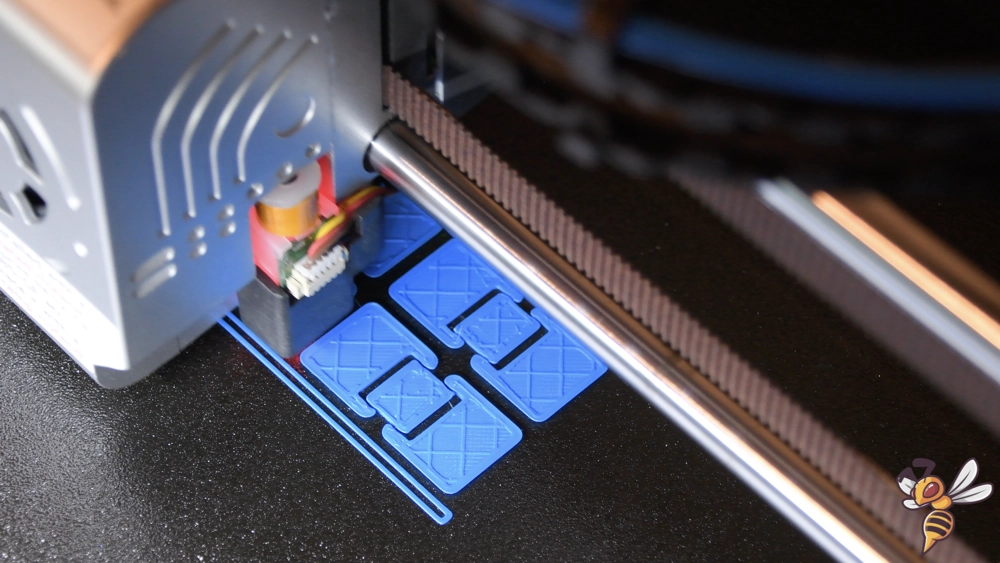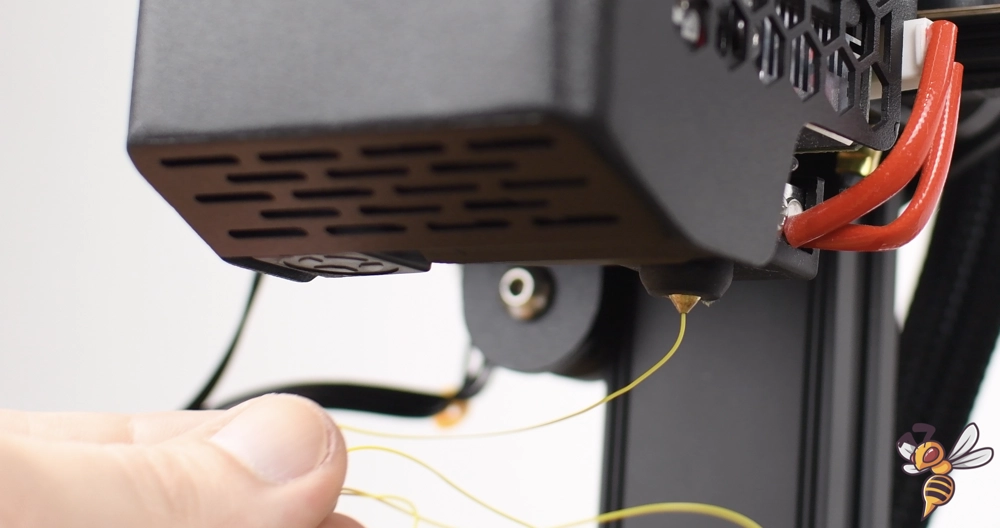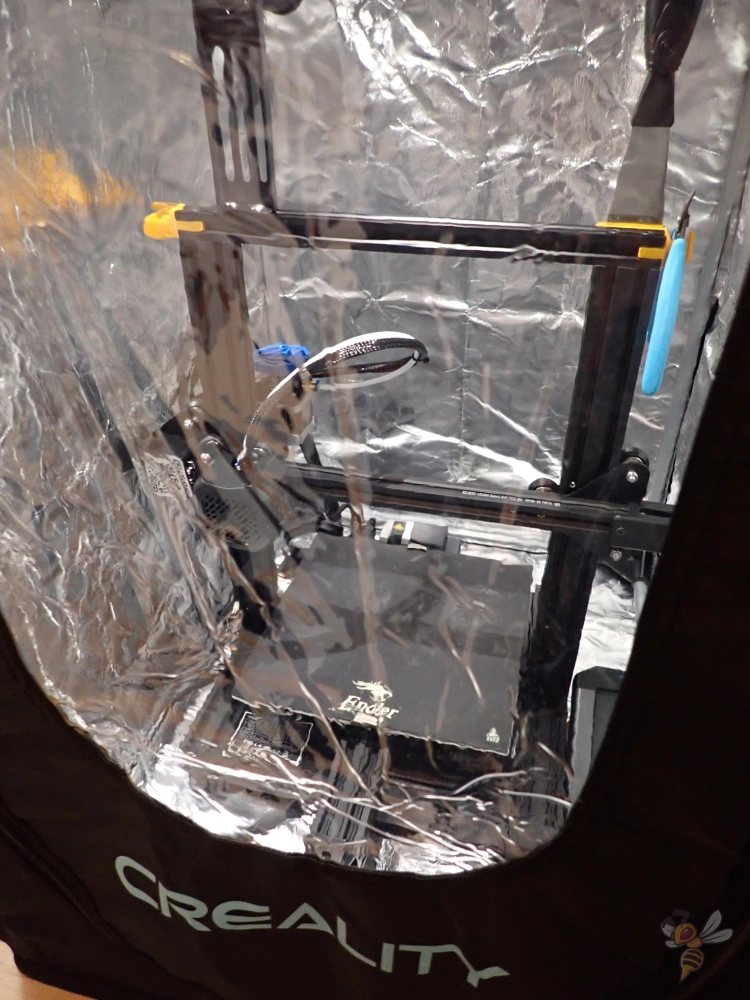- Is a Wash & Cure Station Worth It? Creality UW-03 Review - April 29, 2024
- Z Seam | How to Hide & Avoid | Cura & PrusaSlicer - April 20, 2024
- Qidi Tech Q1 Pro – Best Orca Slicer Settings & Profile - April 9, 2024
Disclosure: Links marked with * are Affiliate Links. I earn from qualifying purchases if you decide to make a purchase through these links – at no additional cost for you!
The safety of PLA fumes has been a subject of concern for many. PLA (polylactic acid) is the most popular and widely used material for 3D printing, due to its low cost, easy accessibility, and environmentally friendly nature. However, many users have raised questions about the potential toxicity of PLA fumes and whether they pose a threat to their health.
3D printing with PLA is generally safe, but still releases fumes and fine particles. While not highly toxic, they may affect health with long exposure. Ensure good ventilation in the printing area to avoid risks.
What these risks are and how to minimize them is the focus of this article. Because sometimes, ventilation alone is not enough for PLA fumes.
Table of Contents:
Are PLA Fumes Toxic?

PLA, while praised for its eco-friendliness, does emit fumes during the 3D printing process. Most research, however, suggests that PLA is generally safe to use in 3D printing.
It’s important to note that “generally safe” does not mean “risk-free” – while PLA fumes are significantly less toxic than those produced by ABS, for example, they can still cause discomfort or allergic reactions in some individuals, especially those with respiratory sensitivity. As with any 3D filament material, proper ventilation is recommended when using PLA.
Based on current research and data, PLA fumes are not considered to be dangerous to a person’s overall health. However, according to a publication from Environmental Science & Technology, prolonged exposure to high concentrations of PLA fumes may lead to cellular toxicity, oxidative stress, and inflammatory responses, potentially compromising lung function and increasing the risk of respiratory disorders.
But, to put things in perspective, living in the city and breathing traffic fumes regularly is way more toxic than sitting in the same room with a 3D printer that prints PLA!
As soon as you ventilate the room regularly, you’ll be fine with PLA filament.
Before diving into the details of avoiding these risks, let’s first understand the exact composition of the fumes.
What are PLA Fumes?

During the printing process, when PLA filament is heated through the 3D printer’s hot end, it releases fumes – a phenomenon common with thermoplastics.
These PLA fumes, consist of various emissions, primarily made up of ultrafine particles (UFPs) and, to a lesser extent, volatile organic compounds (VOCs).
Ultrafine Particles (UFPs)
One of the primary components of PLA fumes is UFPs, which are particles less than 0.1 micrometers in diameter. Their concern lies in their ability to be deeply inhaled into the lungs due to their minuscule size.
Once in the respiratory system, UFPs can aggravate existing conditions such as asthma or cause other respiratory irritations. There’s also the potential for these particles to enter the bloodstream, leading to further systemic health effects.
Volatile Organic Compounds (VOCs)
PLA fumes also contain VOCs, though typically at lower concentrations compared to other 3D printing materials like ABS. VOCs are compounds that easily become vapors or gases, and they can cause different symptoms ranging from eye, nose, and throat irritation to more severe health problems like damage to the liver, kidney, and central nervous system.
The composition of these organic compounds varies based on the specific makeup of the PLA filament and the temperature at which it is extruded.
Although PLA is considered safer for 3D printing with lower emission of harmful substances, its fumes can still contribute to indoor air pollution and pose risks in poorly ventilated spaces. Research indicates that the risk associated with PLA fumes is less severe compared to other materials, but “less severe” doesn’t mean risk-free.
It’s advisable to operate 3D printers in well-ventilated areas, and continual occupational exposure should be minimized.
Risks of Inhaling PLA Fumes & Prolonged Exposure
Note: The below risks can occur at very high doses, which are very unlikely in a normal 3D printing environment. But it’s still important to be aware of these risks and to take necessary precautions to avoid a potential long-term health concern.
- Respiratory Irritation: Prolonged or high-concentration exposure to PLA fumes may cause irritation to the respiratory tract and pose a risk for your respiratory health. Symptoms might include coughing, throat irritation, and shortness of breath, particularly for individuals with pre-existing conditions like asthma or chronic obstructive pulmonary disease (COPD).
- Headaches and Nausea: Individuals exposed to PLA fumes might experience headaches or nausea, likely due to the presence of volatile organic compounds (VOCs) in the fumes. These symptoms can occur after sustained exposure in a poorly ventilated area.
- Eye Irritation: The presence of particulate matter or potentially irritating gases in PLA fumes can lead to eye irritation, manifesting as redness, itching, or a burning sensation.
- Hypersensitivity Reactions: Some people might develop an allergic reaction or hypersensitivity to the components in PLA fumes, especially after repeated exposure. This condition could lead to skin rashes, itchiness, or even more severe respiratory symptoms.
- Cardiovascular Health Impact: Emerging research suggests that UFPs, which are emitted from various sources, including 3D printers, might have implications for heart health. Though direct evidence linking PLA fume exposure to cardiovascular effects is still limited, the general impact of UFPs on the cardiovascular system is an area of ongoing research.
- Potential Long-term Health Effects: The long-term effects of exposure to PLA fumes are still under investigation. Chronic exposure to mixed VOCs and particulates from various sources is associated with a range of health issues, potentially including organ damage or cancer, though evidence specific to PLA fumes is not yet definitive.
- Effects on Development and Reproduction: While there is no direct evidence currently linking reproductive or developmental issues to PLA fumes, other materials with high VOC levels have been associated with such risks. Caution is advised for pregnant individuals or those planning to conceive who work or live in close proximity to 3D printer.
How to Reduce the Risks from Harmful 3D Printer Fumes
After discussing the potential safety hazards associated with PLA fumes, it is essential to address how one can reduce these risks.
Use Your 3D Printer in a Well-Ventilated Room
The most effective way to minimize exposure to toxic fumes is by using your 3D printer in a well-ventilated room. Regular ventilation with fresh air can greatly reduce concentrations of VOCs and UFPs, minimizing the risks associated with toxic fumes.
Install a Proper Ventilation System
If you frequently use your 3D printer, it is advisable to install a proper ventilation system in your workspace. This can help in removing the toxic fumes emitted by the 3D printer, ensuring clean and safe air.
Use an Air Quality Monitor
Investing in an air quality monitor can help you keep track of the VOC levels and the general air quality in your workspace. This will enable you to take necessary precautions and adjust your ventilation system accordingly.
Use a 3D Printer Enclosure

A 3D printer enclosure can contain the fumes emitted during the printing process, preventing them from spreading into your living or working space. This can be a great option for those who do not have a dedicated workspace for their 3D printer.
This enclosure from Creality is my favorite.
Install Air Cleaners/Filters
Air cleaners or filters can effectively reduce the concentration of harmful particles. They work by trapping these particles, preventing them from circulating and affecting your health.
Activated carbon filters work by adsorption, meaning that pollutant molecules in the air are trapped in the pore structure of the carbon substrate. These filters are known to be effective in capturing volatile organic compounds (VOCs), odors, and other gaseous pollutants.
While PLA is known for its low emission rate and general safety compared to other filaments, there may still be some minimal off-gassing of VOCs or other odorous compounds during printing, which activated carbon filters can help mitigate.
Several 3D printer manufacturers include these filters in their systems precisely because of their ability to capture these airborne chemicals, improving air quality around the 3D printer, especially in poorly ventilated areas. While they are often associated with resin 3D printers because of the stronger fumes typically emitted from resins, they can be beneficial for filament 3D printers as well.
In my workspace, I primarily use these filters* whenever I 3D print with any type of filament or resin.
Wear a Respirator Mask
For added protection, consider wearing a respirator mask while 3D printing. A respirator mask can filter out small particles and harmful chemicals in the air that may be emitted by the 3D printer and the filament.
When choosing a respirator mask, look for one with an N95 or N99 rating. These ratings indicate the filter’s effectiveness in blocking out particles of different sizes.
But wearing a mask is not necessary for healthy individuals in a well-ventilated room. Only if you have asthma, allergies, or respiratory issues, it’s a good idea to use a mask (and to consult a doctor before using any 3D printer).
Use Only High-Quality Filament
Some low-quality filaments may contain harmful substances that can be released into the environment after melting. This is why it’s essential to use high-quality filaments from reputable manufacturers.
Printer Farms Need More Ventilation
If you use more than one 3D printer simultaneously in one room, you have to consider all the above measures even more.
A notable study for this investigated the concentrations of particulates and VOCs generated by 3D printers in a university workroom. The research highlighted that under a worst-case scenario, where multiple machines were printing with PLA filament simultaneously, there was a significant increase in total particulate levels (0.7 mg/m3 compared to 0.3 mg/m3 under typical single printer operation).
There was also a six-fold rise in VOCs, with isopropyl alcohol being the predominant compound detected (Reference).
Although these findings showed concentrations below occupational exposure limits, suggesting a low risk of adverse health effects, they underline the importance of continuous monitoring and adherence to good ventilation or air filtering in such settings.
FAQ – Frequently Asked Questions
Which Filaments Release Toxic Fumes?
Certain 3D printing filaments release fumes that may contain toxic elements, particularly when heated. Here are some commonly used materials known for more significant emissions:
- ABS (Acrylonitrile Butadiene Styrene): ABS filament releases styrene, a chemical that is considered carcinogenic, during FDM printing. Prolonged exposure to high concentrations of this carcinogenic VOC can affect the nervous system and cause other issues. One example of this is a case study that revealed a correlation between 3D printing with ABS filaments in a confined space and the resurgence of asthma symptoms, which alleviated after switching to PLA (Reference).
- Nylon: Printing with nylon filaments can emit caprolactam, a compound known to cause irritation in the eyes, nose, throat, and skin. While generally considered less harmful than styrene, it’s still crucial to minimize exposure.
- Polycarbonate and other high-temperature plastics: These materials require higher printing temperatures, leading to the release of more potent fumes, including bisphenol A (BPA), which is a concern due to its potential endocrine-disrupting properties.
- PETG (Polyethylene Terephthalate Glycol): PETG filament combines strength and ease-of use in a single material, often considered the perfect compromise between ABS and PLA. PETG does release VOCs when heated, though less significantly than other materials like ABS filaments. Compared to PLA filaments, PETG’s emissions are slightly higher, but PETG fumes are generally not considered harmful with proper ventilation.
How Do I Know If My 3D Printer Is Emitting Harmful Fumes?
Identifying harmful fumes from your 3D printer isn’t always straightforward, as these emissions can be odorless and invisible. However, there are several signs and methods to help you determine if your 3D printer is emitting potentially harmful fumes:
- Odor: A strong, unpleasant, or chemical smell during printing is a primary indicator. Materials like ABS filament, for instance, tend to emit a noticeable stench, whereas PLA is often less offensive. Any strong odor should be a sign to improve ventilation, even if the exact toxicity levels of the fumes are unknown.
- Physical Symptoms: If you experience headaches, dizziness, nausea, or eye, nose, and throat irritation while your 3D printer is operating, it might be due to harmful fumes. Pay attention to any immediate health symptoms, especially during or shortly after printing sessions.
- Material Safety Data Sheets (MSDS): Check the MSDS provided by the filament manufacturer. These sheets contain information about the potential health risks of the product and safety precautions to take when using them. They might not specify the fumes during printing, but they will inform you about the hazards associated with the raw materials.
- Use of Sensors or Monitors: Some tech-savvy users or those in commercial settings use indoor air quality monitors to detect increases in VOCs or UFPs. These increases often indicate the presence of potentially harmful fumes.
- Observation of 3D Printer Conditions: Filaments emitting more fumes often require higher temperatures to print. If your 3D printer operates at higher temperatures, it might be more likely to produce harmful fumes.
In any case, it is wise to take precautions like printing in well-ventilated areas, using air purifiers, and minimizing your time in close proximity to the 3D printer while it’s operating. If you suspect harmful emissions, it’s better to err on the side of caution and enhance your safety measures.
Do PLA Fumes Pose a Risk to Children or Pets?
Children have more sensitive respiratory systems, and chronic exposure to even low levels of emissions might have health implications. Although PLA filament fumes are only harmful in very high concentrations and a long exposure, children might be particularly sensitive to them.
For pets, especially birds, the situation can be more critical, as birds have extremely sensitive respiratory systems. Therefore, it’s recommended to keep 3D printers away from areas where pets, particularly birds, spend time.
Can Household Air Purifiers Eliminate PLA Fumes?
Household air purifiers can be somewhat effective in reducing the concentration of certain contaminants, including some of the particulates and gases emitted during 3D printing with PLA. However, their efficacy can vary significantly based on several factors:
- Type of Air Purifier: Air purifiers equipped with a HEPA filter are effective at capturing particulates, including the particles that can be emitted during 3D printing. However, these HEPA filters are not designed to remove gas-phase pollutants often found in 3D printer emissions, such as volatile organic compounds (VOCs).
- Activated Carbon Filters: Air purifiers that include an activated carbon filter can absorb VOCs and other fumes, helping to reduce odors and potentially harmful gas-phase emissions during the 3D printing process. It’s important that these filters are adequately sized and regularly replaced to maintain their effectiveness.
Further above in this article, I linked to my favorite air filters to avoid toxic particles. I use them even for PLA filament fumes.
How Can I Recognize Symptoms of Exposure to PLA Fumes?
Recognizing symptoms of exposure to PLA fumes can be subtle, as they often resemble common reactions to indoor allergens. Typical signs include irritation of the eyes, nose, or throat, headaches, dizziness, or nausea.
In more sensitive individuals, such as those with asthma, exposure might trigger respiratory symptoms like coughing, wheezing, or shortness of breath. If you experience these symptoms consistently while 3D printing, it’s crucial to improve ventilation, implement air purification, and consult a healthcare professional if symptoms persist.
Conclusion
No printing material is 100% free of emissions, not even PLA. So proper ventilation, consistent monitoring, and potentially using an air purifier are recommended practices for 3D printing.
But PLA is the safest and healthiest option currently available on the market.
So, don’t let fear of PLA fumes stop you from exploring the fantastic world of 3D printing! With proper precautions and responsible use, you can enjoy this technology without sacrificing your health. Happy printing!
Disclosure: This website is the property of Martin Lütkemeyer and is operated by Martin Lütkemeyer. Martin Lütkemeyer is a member of the Amazon Services LLC and other Affiliate Programs. These are affiliate advertising programs designed to enable websites to earn advertising revenue through advertising and linking to Amazon.com and others. Links marked with * are affiliate links.

